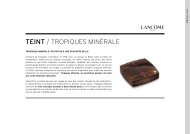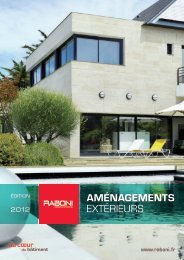Art Market Magazine - Visit zone-secure.net
Art Market Magazine - Visit zone-secure.net
Art Market Magazine - Visit zone-secure.net
Create successful ePaper yourself
Turn your PDF publications into a flip-book with our unique Google optimized e-Paper software.
THE MAGAZINE HERITAGE<br />
<strong>Art</strong> serving the environment<br />
Though the union of "art" and "sustainable<br />
development" seems rather vague, it has to<br />
be admitted that it is "on trend" and that<br />
when we look into it, this association is<br />
ancient, legitimate and, very simply, natural.<br />
But what does "art and sustainable development" really<br />
mean? "It would be better to talk about the environmental<br />
question, which is a broader, less political term,"<br />
says environmental aesthetics specialist Nathalie Blanc,<br />
Director of Research at the CNRS (French National Centre<br />
for Scientific Research), and author, among other books,<br />
of "Ecoplasties, <strong>Art</strong> et Environnement", written with art<br />
historian Julie Ramos. "There are several relationships<br />
between art and the environment, not merely one.<br />
There are militant artists for whom ecological issues are<br />
the central question. Their activist approach makes use<br />
of posters and <strong>net</strong>works. Others, sensitive to the materiality<br />
of places, speak poetically of an environmental form<br />
of aesthetic through their works. Still others work with<br />
scientists and create set-ups for maintaining the environment."<br />
For example, Gilles Bruni, Mark Dion, Olafur<br />
Eliasson, herman de Vries, and even Atelier Van Lieshout,<br />
Alexis Rockman, Iain Baxter&, Lucy+ Jorge Orta, go<br />
beyond practices mingling art and science. These go<br />
hand in hand with a historical approach as well, like that<br />
of the American artist Alan Sonfist, who collaborated in<br />
the layout of new parks in New York, which he enriched<br />
with work on the memory of biodiversity through his<br />
project "Time Landscape" (1965-1978). Others use<br />
symbols and the way works can trigger something in our<br />
consciousness. For instance with "Dynamo-Fukushima"<br />
presented at the Grand Palais in 2011, the plastic artist<br />
Yann Toma invited us to pedal away on bicycles that lit<br />
up light bulbs. A participative work designed to transmit<br />
artistic energy in a gesture of solidarity with Japan. A<br />
sensitive application of the "social ecology" and "grey" or<br />
mental ecology advocated by the philosopher Félix<br />
Guattari… In a word, all these proposals have the merit<br />
of engaging a dialogue with viewers, who can then<br />
provide their own interpretation. And some of the ideas<br />
aren't new. The American land art movement appeared<br />
in the Sixties. Does this mean that Robert Smithson was<br />
expressing a strong ecological awareness of nature in his<br />
"Spiral Jetty" of 1970? "His relationship with nature was<br />
ironic, and at its expense," says our specialist, Nathalie<br />
Blanc. Nevertheless, by creating external environments,<br />
and by drawing attention to industrial dumps within<br />
natural landscapes, land artists broke new ground. As<br />
with many fields, recognition was slow in coming. Nearly<br />
thirty years went by between the first works and the<br />
49 soils from different areas of Japan, water from Chamarande<br />
and small glass dishes, Dimensions variables. Courtesy of the<br />
artist Adaptation for the estate of Chamarande.<br />
© Laurence Godart
















